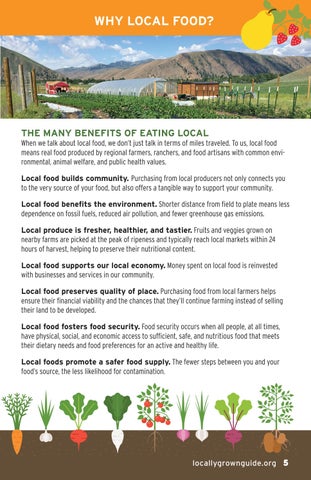WHY LOCAL FOOD?
THE MANY BENEFITS OF EATING LOCAL When we talk about local food, we don’t just talk in terms of miles traveled. To us, local food means real food produced by regional farmers, ranchers, and food artisans with common environmental, animal welfare, and public health values. Local food builds community. Purchasing from local producers not only connects you to the very source of your food, but also offers a tangible way to support your community. Local food benefits the environment. Shorter distance from field to plate means less dependence on fossil fuels, reduced air pollution, and fewer greenhouse gas emissions. Local produce is fresher, healthier, and tastier. Fruits and veggies grown on nearby farms are picked at the peak of ripeness and typically reach local markets within 24 hours of harvest, helping to preserve their nutritional content. Local food supports our local economy. Money spent on local food is reinvested with businesses and services in our community. Local food preserves quality of place. Purchasing food from local farmers helps ensure their financial viability and the chances that they’ll continue farming instead of selling their land to be developed. Local food fosters food security. Food security occurs when all people, at all times, have physical, social, and economic access to sufficient, safe, and nutritious food that meets their dietary needs and food preferences for an active and healthy life. Local foods promote a safer food supply. The fewer steps between you and your food’s source, the less likelihood for contamination.
locallygrownguide.org 5















